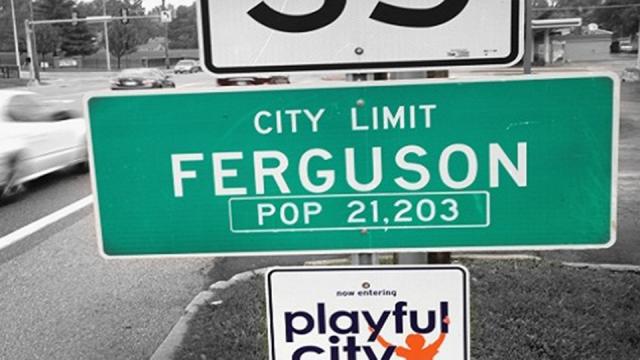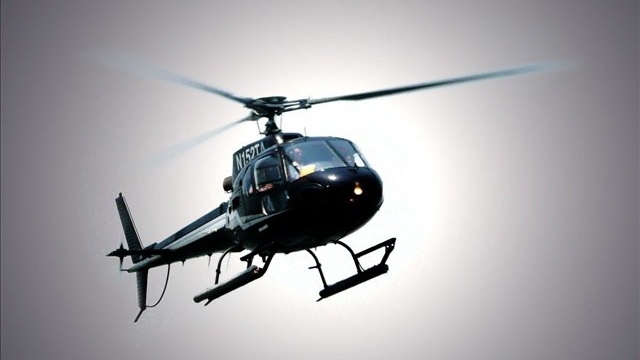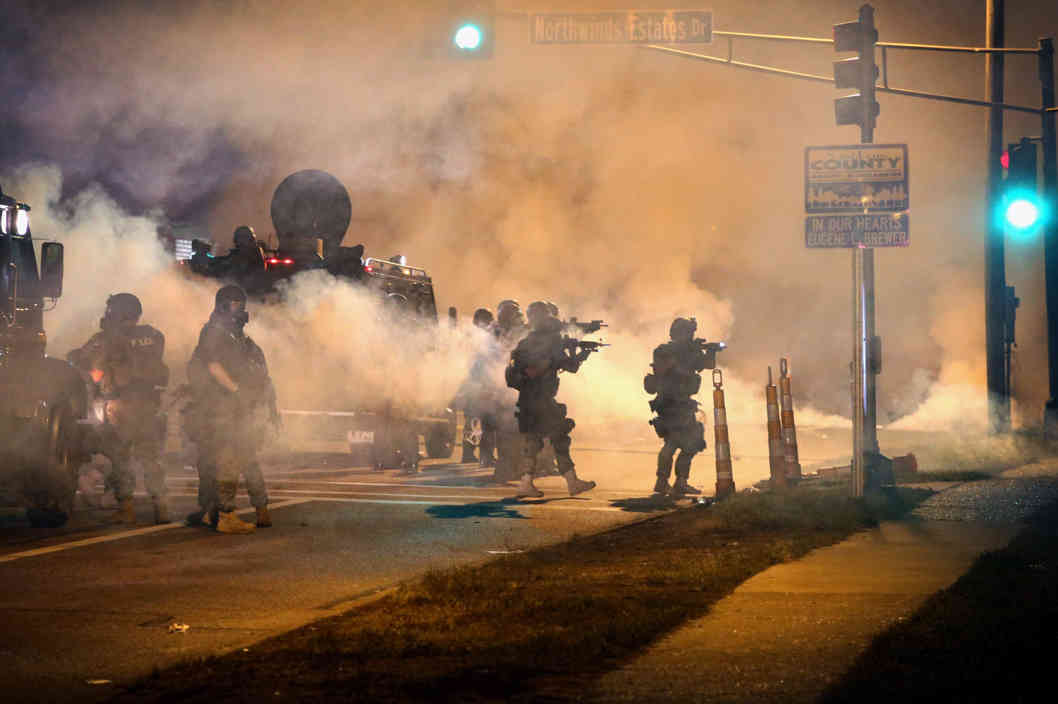
Police in Ferguson, Missouri, asked the U.S. government to restrict 37 square miles of airspace above the city primarily to stop media helicopters from recording TV news footage during a week of rioting in August, audio recordings have revealed.
On Aug. 12, the morning after the Federal Aviation Administration (FAA) imposed the first flight restriction, air traffic managers struggled to redefine the temporary flight restriction (TFR) in order to allow police aircraft and commercial flights to operate at the nearby Lambert-St. Louis airport.
“They finally admitted it really was to keep the media out,” said one FAA manager about the St Louis County police request, in a series of recorded telephone conversations obtained by the Associated Press after a freedom of information request. “But they were a little concerned of, obviously, anything else that could be going on.”
At one point an FAA employee in Kansas City said police “did not care if you ran commercial traffic through this TFR all day long. They didn’t want media in there.”
“There is really … no option for a TFR that says, you know, ‘OK, everybody but the media is OK,’” he said. The managers then worked out wording they felt would keep news helicopters out of the controlled zone but not impede other air traffic.
The conversations contradict claims by the St. Louis County police department, which was criticized for its forceful response to demonstrations in the wake of the shooting death of 18-year-old Michael Brown at the hands of one of its officers.
Police said the restriction was solely for safety and had nothing to do with preventing media from witnessing the violence or the police response.
Police said at the time – and on Friday to the AP – that they requested the flight restriction in response to shots fired at a police helicopter. However, police officials confirmed there was no damage to their helicopter and were unable to provide an incident report on the shooting.
On the tapes, an FAA manager described the helicopter shooting as unconfirmed “rumors.”
The AP obtained the recordings under the U.S. Freedom of Information Act. They raise serious questions about whether police were trying to suppress aerial images of the demonstrations and the police response by violating the constitutional rights of journalists with tacit assistance by federal officials.
Such images would have offered an unvarnished view of one of the most serious episodes of civil violence in recent memory.
“Any evidence that a no-fly zone was put in place as a pretext to exclude the media from covering events in Ferguson is extraordinarily troubling and a blatant violation of the press’s first amendment rights,” said Lee Rowland, an American Civil Liberties Union staff attorney specializing in first amendment issues.
One FAA manager modified the flight restriction so that planes landing at Lambert still could enter the airspace around Ferguson.
The less-restrictive change practically served the authorities’ intended goal, an FAA official said: “A lot of the time the [lesser restriction] just keeps the press out, anyways. They don’t understand the difference.”
The Kansas City FAA manager then asked a St. Louis County police official if the restrictions could be lessened so nearby commercial flights wouldn’t be affected.
The new order allows “aircraft on final [approach] there at St Louis. It will still keep news people out… The only way people will get in there is if they give them permission in there anyway so they, with the [lesser restriction], it still keeps all of them out.”
“Yeah,” replied the police official. “I have no problem with that whatsoever.”
KMOV-TV news director Brian Thouvenot told the AP that his station was prepared at first to legally challenge the flight restrictions, but was later advised that its pilot could fly over the area as long as the helicopter stayed above 3,000ft.
That kept the helicopter and its mounted camera outside the restricted zone, although filming from such a distance, he said, was “less than ideal.”
None of the St. Louis stations was advised that media helicopters could enter the airspace even under the lesser restrictions, which under federal rules should not have applied to aircraft “carrying properly accredited news representatives.”
The FAA’s no-fly notice indicated the area was closed to all aircraft except police and planes coming to and from the airport.
“Only relief aircraft operations under direction of St. Louis County police department are authorized in the airspace,” it said. “Aircraft landing and departing St. Louis Lambert airport are exempt.”
Ferguson police were widely criticized for their response following the death of Brown, who was shot by a city police officer, Darren Wilson, on 9 August. Later, under county police command, several reporters were arrested, a TV news crew was tear-gassed and some demonstrators were told they weren’t allowed to film officers.
In early October, a federal judge said the police violated demonstrators’ and news crews’ constitutional rights.
“Here in the United States of America, police should not be bullying and arresting reporters who are just doing their jobs,” President Barack Obama said on Aug. 14, two days after police confided to federal officials the flight ban was secretly intended to keep media helicopters out of the area. “The local authorities, including police, have a responsibility to be transparent and open.”
The restricted flight zone initially encompassed airspace in a 3.4-mile radius around Ferguson and up to 5,000ft in altitude, but police agreed to reduce it to 3,000ft after the FAA’s command center in Warrenton, Virginia, complained to managers in Kansas City that it was impeding traffic into St. Louis.
A police official assured the FAA he had no objections to commercial air traffic entering the zone, according to one recording.
The flight restrictions remained in place until Aug. 22, FAA records show. A police captain wanted it extended when officials were set to identify Wilson by name as the officer who shot Brown and because Brown’s funeral would “bring out the emotions,” the recordings show.
“We just don’t know what to expect,” he told the FAA. “We’re monitoring that. So, last night we shot a lot of tear gas, we had a lot of shots fired into the air again. It did quiet down after midnight, but with that … we don’t know when that’s going to erupt.”
The recordings do not capture early conversations about the initial flight restriction imposed a day earlier, but they nonetheless show the FAA still approved and modified the flight restriction after the FAA was aware that its main intent was to keep the media away.
One FAA official at the agency’s command center asked the Kansas City manager in charge whether the restrictions were really about safety. “So are [the police] protecting aircraft from small-arms fire or something?” he asked. “Or do they think they’re just going to keep the press out of there, which they can’t do.”
3 WAYS TO SHOW YOUR SUPPORT
- Log in to post comments


















